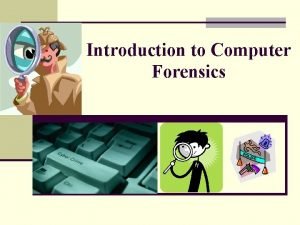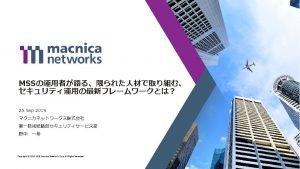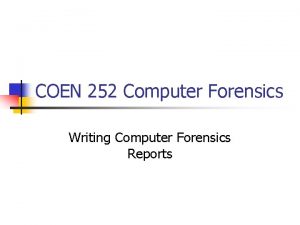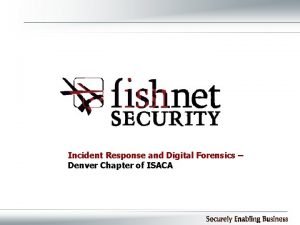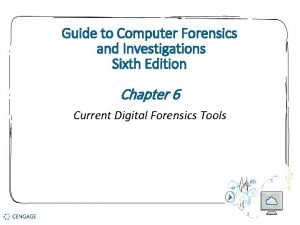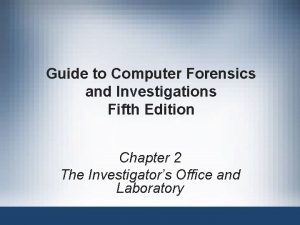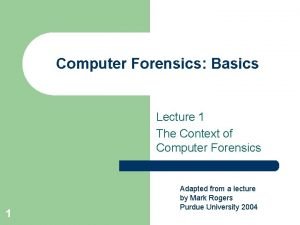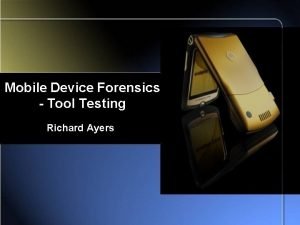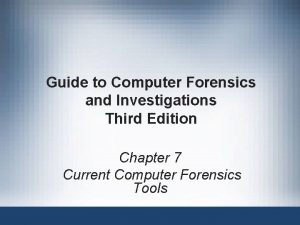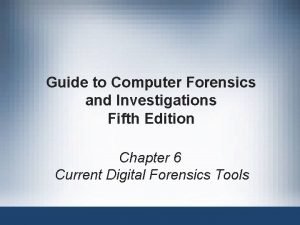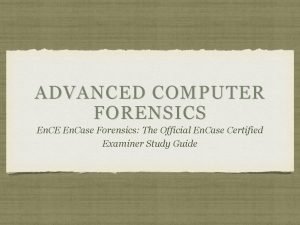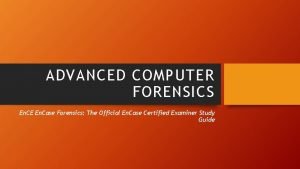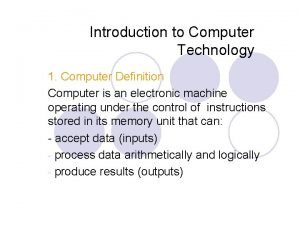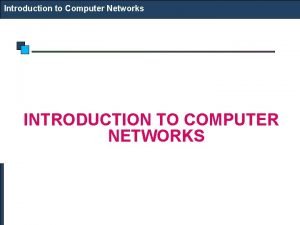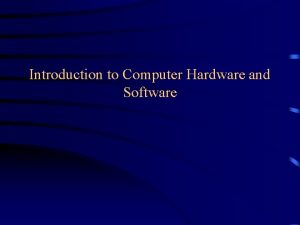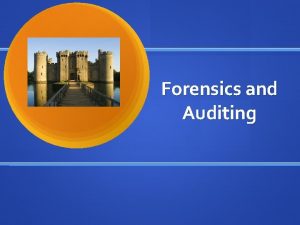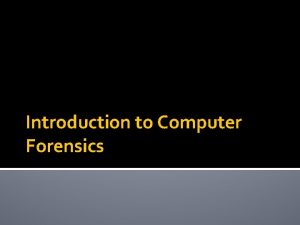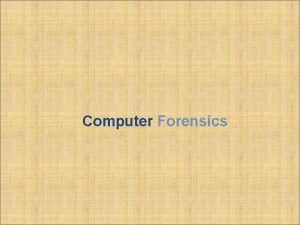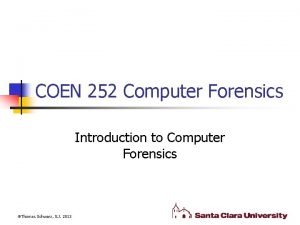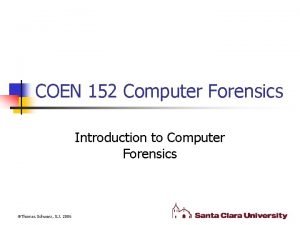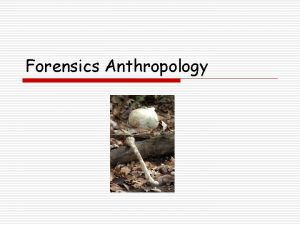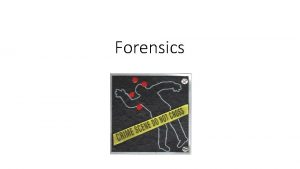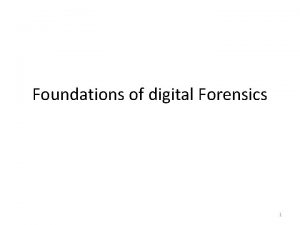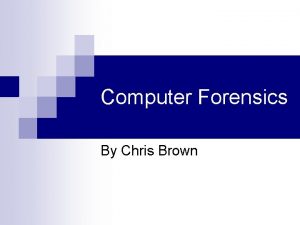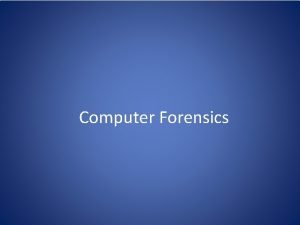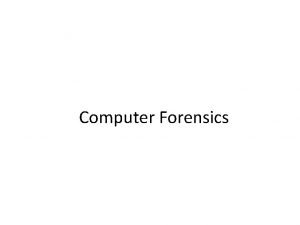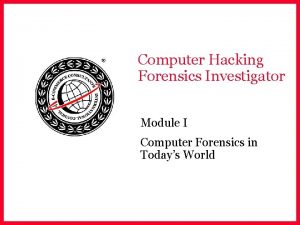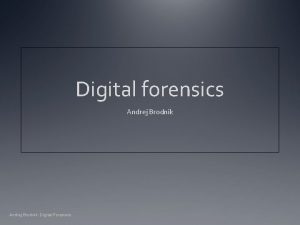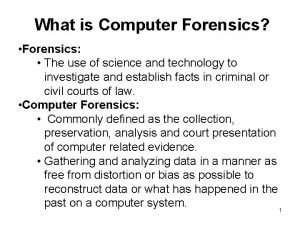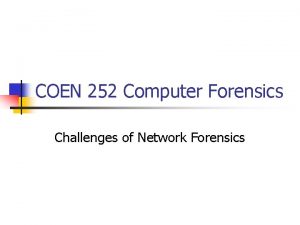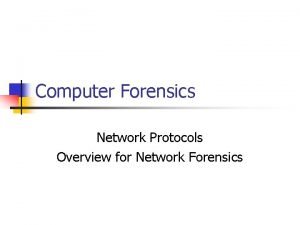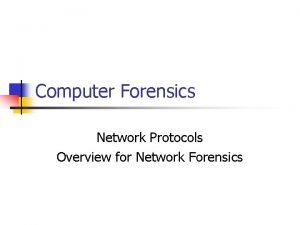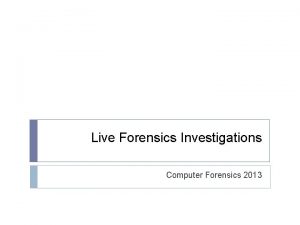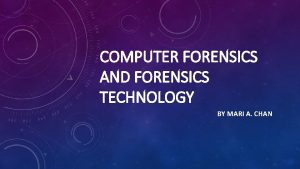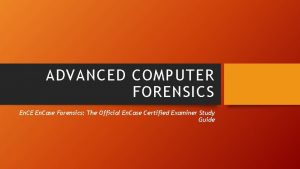Forensics An Introduction to Computer Forensics Copyright 2019

























- Slides: 25

Forensics An Introduction to Computer Forensics Copyright © 2019 - Curt Hill

Forensic Definitions • Scientific tests or techniques used in connection with the detection of crime • The process of using scientific knowledge for collecting, analyzing, and presenting evidence to the courts • Pertaining to, connected with, or used in courts of law or public discussion and debate Copyright © 2019 - Curt Hill

What is it? • Forensics deals primarily with the recovery and analysis of latent evidence • In our case it usually is after a breach or the injection of malware • We are looking for several things: – The perpetrator(s) – The means of entry or attack – The items that were damaged, stolen or exposed – Residual malware Copyright © 2019 - Curt Hill

Why do we care? • Will help with the prosecution of the perpetrator • Will help the survivability of the system • Avoid the destruction of evidence • There are liabilities for not protecting data that is regulated – Civil and criminal Copyright © 2019 - Curt Hill

Attention to Detail • In general, forensics deal with gathering and presenting evidence in court – We will consider some of the legal requirements later • The study of computer forensics is valuable even if the evidence will never see a court of law – Preservation of the evidence helps to make the system more secure Copyright © 2019 - Curt Hill

What to look for? • Considerable variance in the crimes that are committed – In a child pornography we are looking for images/videos or evidence of their existence as well as the source – In data loss we are looking for damaged files and the malware that did this • Two basic forms of data – Persistent – Volatile Copyright © 2019 - Curt Hill

Persistent data • This is data that may survive a power loss • Usually located on a disk drive or other storage • We must be careful to not change this data in our investigation • Forensics workers need to know the tools to examine Copyright © 2019 - Curt Hill

Volatile • This is the data in memory, or being transmitted through the network – May be in a registry, a cache, RAM • This can only be accessed while the computer/network has remained powered up since the attack • The forensic technician needs a different set of tools to find items in the running computer Copyright © 2019 - Curt Hill

Process • There are many different processes that have been proposed – Most are specific to a particular environment such as incident response of law enforcement • What they largely have in common is three basic steps: – Acquisition – Analysis – Report Copyright © 2019 - Curt Hill

Acquisition • The concern that must be addressed is that an exact copy is obtained • This must be subject to examination without change that could obscure evidence • For storage devices the first thing is to make a sector by sector copy onto another device that may be write protected – Verify this with hash functions • Original is stored for later comparison Copyright © 2019 - Curt Hill

Drive Duplicators • There a number of such duplicators – En. Case, Forensic Toolkit (FTK) Imager, DCFLdd, IXimager, Guymager, True. Back or FDAS • Imaging software may also be used – For example the software VCSU uses to image laptops Copyright © 2019 - Curt Hill

Volatile data • If the machine is running memory may have valuable data that cannot be preserved if the machine is shut down • Two live analysis tools – Computer Online Forensic Evidence Extractor (COFEE) contains tools for password decryption, internet history display and snapshots of memory – Windows. SCOPE shows processes, DLLs, drivers, open network sockets, file handles and registry key handles Copyright © 2019 - Curt Hill

Analysis • Systematic search of data relevant to the suspected crime • This looks at existent and deleted files that may be relevant – Relevance depends on the crime – Files may include emails, browser histories or images – Recovering deleted files is seen next • There are tools for examining these • The data is then used to attempt to reconstruct what actually happened Copyright © 2019 - Curt Hill

Deletion • File deletion is not quite as secure as one might think • Deletion often puts files in a trash or recycle bin that may be inspected after the deletion • Emptying this bin typically does two things – Marks the directory entry as unused – often by writing a single byte – Moving the data sectors to the list of available sectors Copyright © 2019 - Curt Hill

Recovery • Most of the information still exists for a time • The information in the directory still exists with one or a few bytes overwritten – The missing bytes can usually be guessed – The sector locations will usually still be present, so they may be recovered from the available sectors list • The available sectors list may also be scanned Copyright © 2019 - Curt Hill

Secure Deletion • Typically a single file contents are modified in place or the entire disk is overwritten – Each sector is updated to obscure the contents – This is usually done multiple times • Even that may not be enough – Sensitive equipment may be able to read the margins of the track and reconstruct original contents – Very hard to do and usually only by security agencies Copyright © 2019 - Curt Hill

Track Diagram Track 4 Track 5 Track 6 Track boundary Main Track Area Track Margin Track Edge Copyright © 2019 - Curt Hill

Secure Deletion • If the data is securely deleted then it is not recoverable – Although backups and logs may provide some information • Similarly, the longer the item was insecurely deleted, the less likely useful information may be found – Reusing the directory entry or the sectors will occur – This reuse will remove the information Copyright © 2019 - Curt Hill

Stochastic Forensics • Most analysis requires the use of artifacts, usually files or information in files • Stochastic forensics is used to reconstruct actions without these – Invented to investigate insider data theft which typically leaves no trail • Involves statistically analyzing the meta data generated by the file system Copyright © 2019 - Curt Hill

Report • This is the report to the courts or prosecutor as to what happened – Should be phrased in non-technical language • This step may be omitted if not used in a legal proceeding – However, in many cases some report will recommend security changes that are needed Copyright © 2019 - Curt Hill

Tools • There a variety of tools • These include Operating Systems specialized towards forensics and packages that are helpful • An Ubuntu based Linux named CAINE – Computer Aided INvestigative Environment – Is a live CD/DVD to prevent changing the system disk • Several others as well Copyright © 2019 - Curt Hill

Several tools • There a few free tools – Autopsy – Digital Forensics Framework – Open Computer Forensics Architecture – The Sleuth Kit • There are more which are proprietary – two common ones: – En. Case – FTK (Forensic Tool Kit) Copyright © 2019 - Curt Hill

Evidentiary Requirements • Like in many cyber areas, legal practice and precedents have lagged • State laws and practices vary • The practitioner should understand the federal laws that are relevant – We have covered these previously • Federal rules on evidence concerning reliability, authentication and hearsay should be understood as well Copyright © 2019 - Curt Hill

Certifications • There are several relevant certifications from groups • International Society of Forensic Computer Examiners (ISFCE) – Certified Computer Examiner • Digital Forensics Investigation Professional (DFIP) • IACRB Certified Computer Forensics Examiner • Notes have some URLs Copyright © 2019 - Curt Hill

Finally • Digital forensics is a series of courses in itself – This has merely hit the high points Copyright © 2019 - Curt Hill
 Computer crime
Computer crime It fw
It fw Computer forensics report template
Computer forensics report template Guide to computer forensics and investigations
Guide to computer forensics and investigations Digital forensics denver
Digital forensics denver Computer forensics workstation
Computer forensics workstation Forensics
Forensics Objectives of computer forensics
Objectives of computer forensics Computer forensics tool testing
Computer forensics tool testing Tasks performed by computer forensics tools
Tasks performed by computer forensics tools Tasks performed by computer forensics tools
Tasks performed by computer forensics tools Computer forenics
Computer forenics Advanced computer forensics
Advanced computer forensics Fastbloc
Fastbloc 2019 apcs frq
2019 apcs frq General objectives of computer
General objectives of computer What is computer organization
What is computer organization Computer input devices drawing
Computer input devices drawing Basic structure of computer system
Basic structure of computer system Architecture and organization difference
Architecture and organization difference Interrupt cycle flow chart
Interrupt cycle flow chart Design of basic computer
Design of basic computer Introduction to computer organization and architecture
Introduction to computer organization and architecture Introduction and definition of computer
Introduction and definition of computer Introduction to computer
Introduction to computer Introduction of computer hardware and software
Introduction of computer hardware and software
